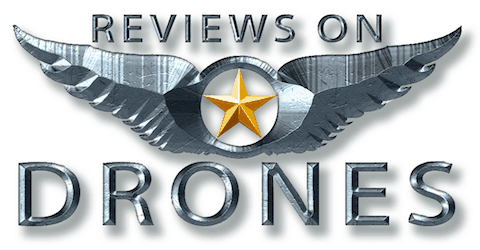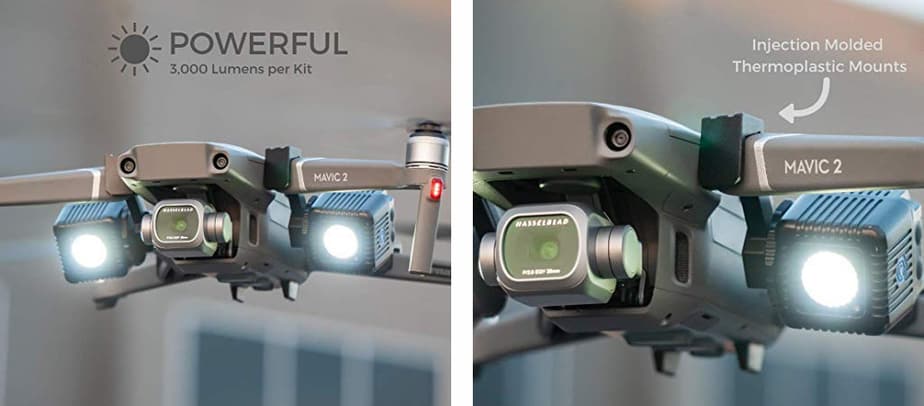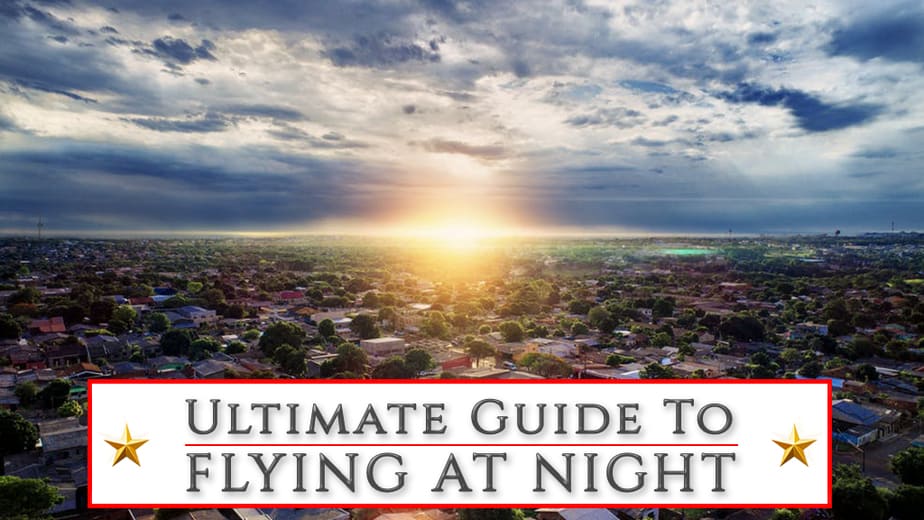
Whether you’re looking to test your drone flying skills by navigating in near darkness, or wanting to snap some truly remarkable evening footage, there’s certainly a stack of fun to be had with night flying.
However, before setting your sights on taking to the skies in the next few nights, it’s important to remember there are a few rules in place that you’re going to want to know, and consider.
And the first of these relates to will you be flying your drone at night as a hobby and for fun, or for work and commercial purposes?
Then of course you’ll need to consider where you’re flying the drone, know whether your drone is correctly (and legally) equipped for the task, understand the safety aspects of flying in the dark, and what steps do you need to take to get the best from your time in the night sky.
And while this may all sound complicated, the truth is, it really isn’t. Spend some time reading the guide, and we all but guarantee you’ll know everything you need to by the time you’re done.
What type of drone pilot are you?

A good place for us to start is by identifying what type of drone pilot you’re planning to be when you fly your drone at night. The FAA – the Federal Aviation Administration – is the organisation in charge of setting all drone flying rules in the US, and they’ve put drone pilots into four main categories:
- Recreation Flyers and Modeler Community Based Organizations
- Certified Remote Pilots including Commercial Operators
- Public Safety & Government Users
- Educational Users
From our research, 90% of drone pilots fall into the first two categories – those that fly for recreation and for business – and so this guide is aimed primarily at these two groups, although we’re confident there’s something in here for everyone.
Please note that whilst the FAA do seem set many of the standards for the aviation industry around the world, they are in fact only responsible for flying rules in the United States… and so if you’re reading this and not from the US, or you are potentially travelling to a destination outside the US, we strongly suggest you research who you’re local Aviation Administrator is, and confirm what their position is on flying a drone at night.
Rules for Flying a Drone at Night as a Hobbyist
Okay, so the good news for pilots intending on flying their done at night for fun in the US is that there actually aren’t many stiff rules in place – most of it is common sense, and you should be ready to hit the sky in no time.
The FAA safety rules are straight-forward and should be simple to follow. These rules include:
- Following all community-based safety guidelines
- Always flying the UAS* inside your line of sight – observers can be used if needed
- Stay well clear of manned aircraft and always give way to one if necessary
- Never fly within 5 miles of an airport unless you have notified the airport/air traffic controller prior to flying within this radius and received permission
- Flying a UAS with a maximum weight of 55lbs
(* UAS is an all encompassing term for everything that makes a drone / unmanned aerial vehicle operate. It includes the drone and the ground control station with pilot, communications, support equipment etc.)
So providing you’re only flying the drone recreationally and within safety guidelines, you should have no problem piloting a drone at night.
However, there are a few important things to remember as a hobbyist, and the first of these – and this is a big one to remember – is that you must ensure you don’t retroactively use the drone for commercial purposes.
For instance, if you take an awesome photo and decide to sell it someone that liked it, you’ve technically flown for commercial purposes and broken the law by illegally flying at night. So be careful what you do with any photos, videos, and other data captured when flying, even as a hobbyist.
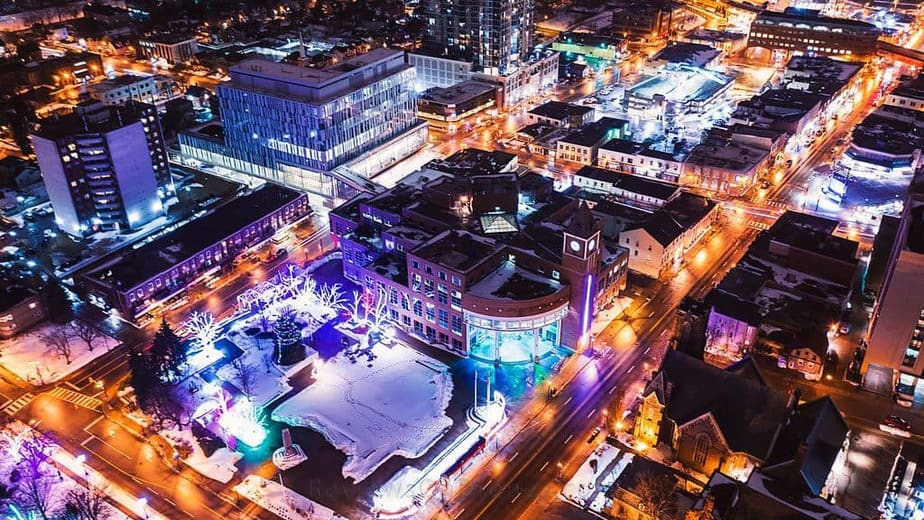
It’s also worth mentioning that you’re still liable when flying as a hobbyist. You may be disturbing a neighbors privacy or alarm someone to the point where law enforcement may come calling, so please be mindful of any issues your night flying may cause to others and the environment.
Again, most of this is common sense and if you have experience flying drones, you’ll know exactly what approach to take when flying at night. Basically, a bit more caution and some extra awareness of the risks of night-time flying is all you need.
Now you know the rules that affect you if you’re flying the drone as a hobby, it’s time to get into the rules and regulations for commercial drone pilots looking to fly a night.
Rules for Flying a Drone at Night for Commercial Purposes – Regulation, Laws, Licences, and Waivers
In a few moments we’re going to dive into all the legal jargon regarding night-time drone flying… but please don’t get intimidated by some of the stuff featured in this section and certainly don’t beat yourself up if you need to read some of these points more than once.
Understanding the Rules
If you’re flying a drone at night for commercial purposes then there are certain rules and regulations that you must follow under the FAA’s Part 107, which covers all legalities of drone piloting in the US.
These rules aim to ensure that businesses can continue to use their drones for commercial purposes even at night-time, providing they have the necessary licence and night waiver to conduct this work.
But First, Is Your Drone Even Suitable for Night-Time Flying?
Before we get into the steps involved in obtaining a licence and night waiver, it’s a good idea to check whether your drone is even suitable for night-time flying – because if not, your application will likely be rejected.
Thankfully, it’s not difficult to get your drone ready for flying at night, and there’s just a few things you need to do.
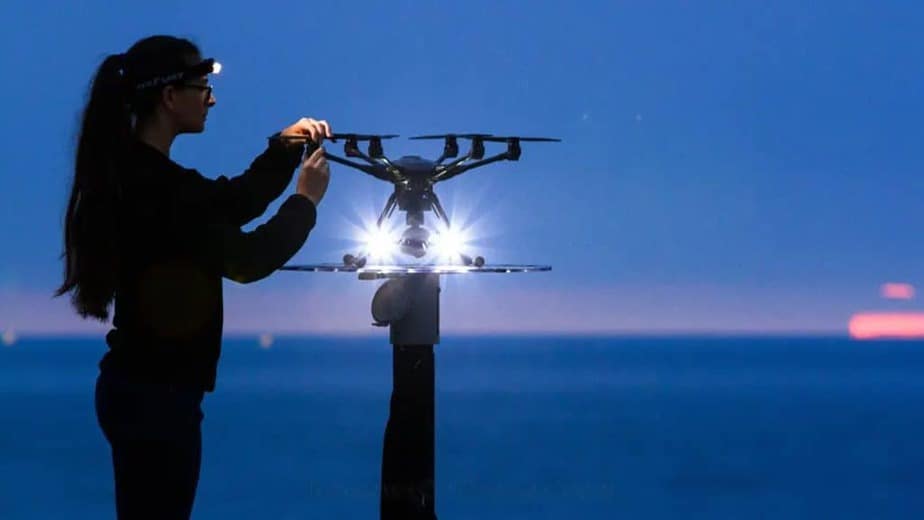
First, you must ensure that the drone is fitted with anti-collision lights – visible for at least 3 statute miles away (4.8kms), and be able to strobe at a frequency of 40-100 times per minute.
Most drones being used for commercial purposes at night already come with anti-collision lighting, so you may not even need to worry about this – but be aware, and certainly check before you apply.
That being said, some lights aren’t the best, and it’s wise to consider buying an aftermarket light and attach it to the drone. These anti-collision lights aren’t too expensive, are easy to buy online, and you should be able to attach them to your drone yourself.
It’s important to note that when buying an aftermarket anti-collision light kit, make sure it’s either a red or white light, and can blink or strobe. If the lights are anything other than this, especially blue or green, they won’t be suitable.
Another important factor is the weight of the drone. Your drone cannot weigh over 55lbs if you want to fly it at night. So, if you’re buying an anti-collision light, consider its weight and what the weight of your final drone will be once it’s attached.
Lastly, remember to ensure that any light you attach is fully weatherproof, safely secured, and whether you may need to attach more than one for the lighting to be visible for 3 miles.
Besides the FoxFury 700-300 Rugo R1 lights which are pictured above, we suggest you also look at the Lume Cube range.
They have two products in particular that are very popular amongst more experienced drone pilots who like to fly at night. The first is their Lume Cube Strobe which can be fixed through their dual lock system to all drones.

And the second product that gets great reviews from DJI pilots is their Mavic Lighting Kit, designed and built specifically for the Mavic 2 Pro and Mavic 2 Zoom. If you own one of these drones then this is definitely a more expensive option. But it’s also probably the best investment you could make if flying at night is something you’re doing or going to be doing a lot of.
Time To Become an FAA-Certified Drone Pilot
(And you must admit, if you’re a newbie that does sound pretty cool right? Sort of TopGun-esk!)
The first step to becoming a certified drone pilot is to get your remote pilot airman certificate from the FAA. This is necessary for most small UAS flying activities (unless you’re doing it recreationally as a hobbyist) – so most people operating drones for commercial reasons will have this.
This certificate is designed to help pilots learn how to safely operate drones under Part 107 rules. You learn what is, and isn’t, allowed when flying a UAS under Part 10, take a knowledge test based on the various rules and regulations, complete the licence form, and then register your drone with the FAA. Simple.
And the good news is that most of this process is now done online, with only the knowledge test requiring you to visit an FAA-approved testing center.
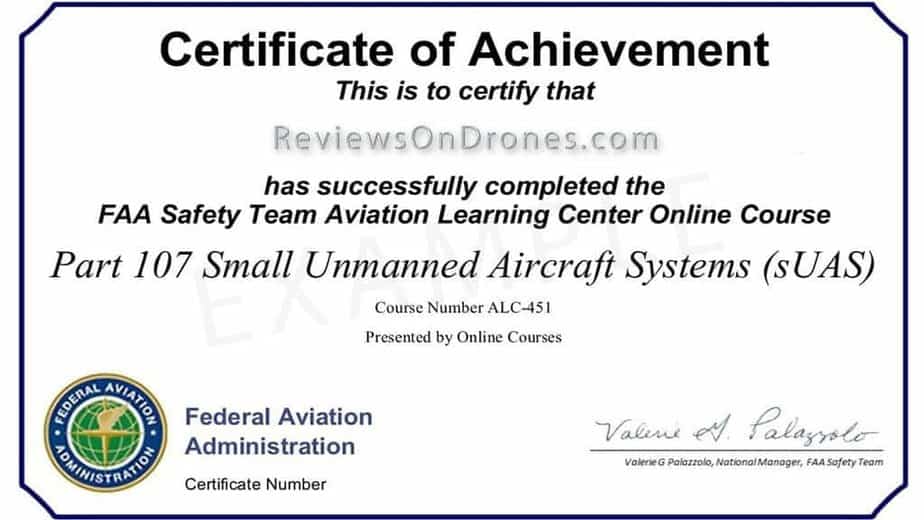
Applying for a Part 107 Night Waiver
If you have an FAA-certified remote pilot’s licence and you want to fly your drone after dark for commercial purposes, then you need to apply for a Part 107 Night Waiver.
This waiver grants permission to fly your drone at night for any type of commercial purpose and is very easy to apply for – the entire process can be quickly completed online.
Once you have registered your drone, simply head over the FAA DroneZone website, sign into your account (or create one if you haven’t already), then file the request for a night waiver.
You’ll need to provide information about what you’re intending on doing with the drone when applying for the night waiver, plus identify any possible risks, and any measures you can take to avoid these risks.
To be honest, when you’re completing this form online for the first time, it’s not that clear how detailed you need to be when applying for the night waiver. And since it’s an online form, it’s easy to leave the bare minimum to save time and effort…
But from our experience, we’d encourage you be as detailed as you can and offer up as much information as possible at the time of application. You might consider:
- What time you’re flying the drone at
- Where you’re flying the drone
- How long you’re flying the drone
- Drone capabilities (i.e. whether it’s suitable for night flying)
- Your drone flying experience and piloting capabilities
Waiting for Confirmation
Be patient after applying for the night waiver – the FAA do state they can take up to 90 days to approve or reject the application… And in some instances you’ll find they contact you for extra information before deciding, so be aware of this and be sure to reply quickly.
Remember, the FAA are within their rights to reject or accept any night waiver application. So don’t get disheartened if they reject yours – you may have missed some important information during the application, so read their feedback and try again.
However, the chances of successfully applying for a night waiver are actually quite high. We’ve been told they have around a 90% acceptance rate… so the odds of a successful application are in your favor!
Why Fly a Drone at Night?
Now, you may be unsure as to why anyone would even want to fly their drone at night. After all, where’s the fun when there very little visibility to see what you’re doing?
Well, first off, night flying can be incredible fun – and certainly offers a different perspective on piloting, challenging your flying capabilities while also giving you the chance the capture some awesome photo and video footage from your drone!
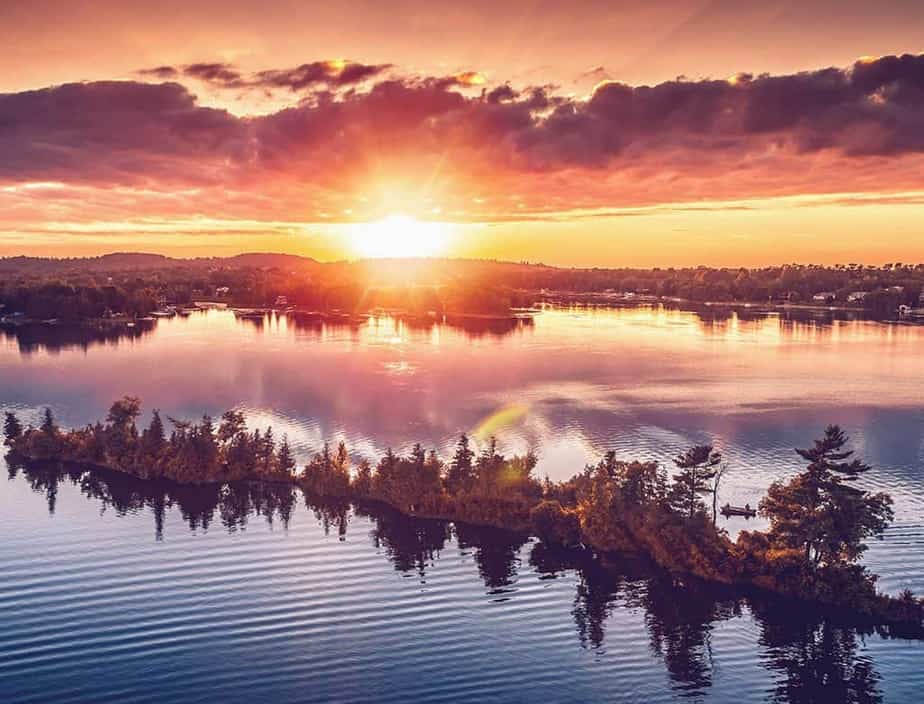
Moreover, when flying commercially, there are many instances where night-time flying is preferred – or even necessary – over daytime flying.
Reasons for Recreational Night-Time Drone Flying
Okay, so let’s think this through. Why on earth would a hobbyist want to fly a drone after sunset? Poor visibility and a higher chance of crashing (or even losing) their drone, maybe just enough for some pilots to say ‘no chance, that’s too risky and just not for me’ – yet there are many who relish the opportunity.
Perhaps the biggest example is with photography. While taking drone photos during the day can provide endless hours of creative fun, taking photos at night is a whole new ball game.
For one, there are some truly breath-taking night-time photo opportunities… from the stars that litter the night sky, to mesmerising neon cityscapes… the entire world takes a new form once the sun goes down, and its ripe for wonderful photographs almost no matter where you are.
For instance, many drone pilots love to take long-exposure photographs, especially in city environments that are illuminated from cars, streetlights, buildings, signs etc.
This process involves using a camera on your drone and setting it to shoot with a slow shutter speed to create a certain effect – by tracing the movements of moving objects against stationary objects (e.g. moving stars on the still night sky) to produce very eye-catching images.
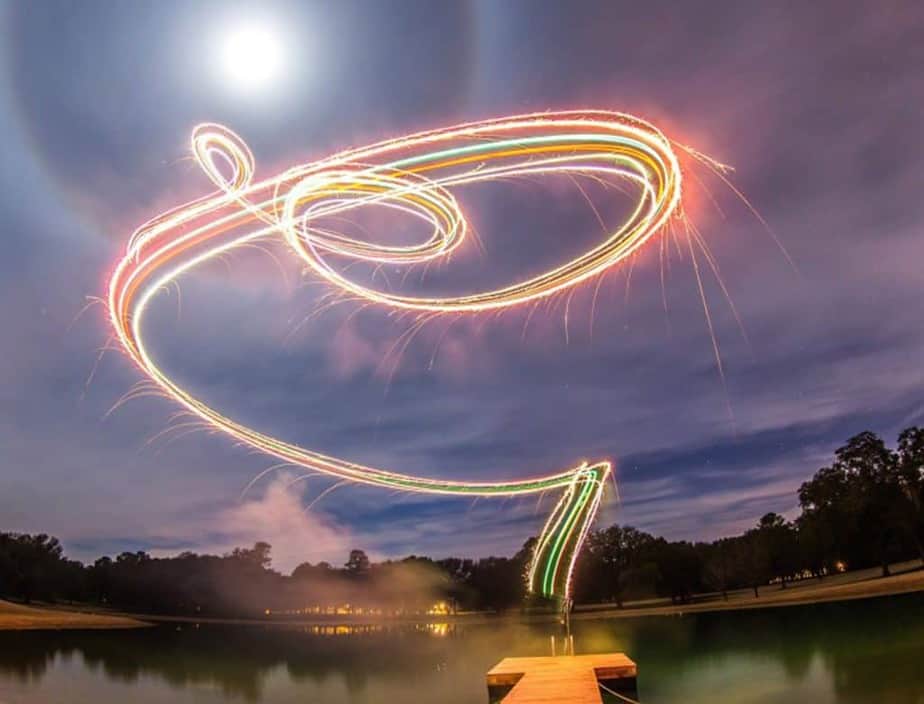
Now of course, not all recreational drone pilots take to the night sky for photography! Many simply enjoy the peace and quiet that the later hours provide, while flying in low visibility is quite challenging so is a good way to test and hone your piloting skills.
Reasons for Commercial Night-Time Drone Flying
Commercial reasons for flying drones at night are more straight-forward – and often they’re as simple as being an essential part of their operation.
Thankfully, the FAA has recognised this and tailored Part 107 to include the ability to fly drones during the night with a night waiver.
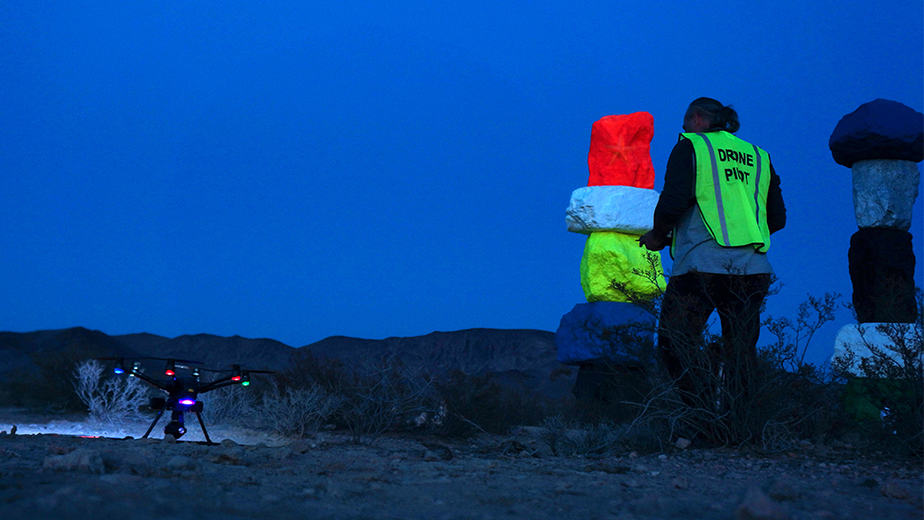
And what type of businesses need to fly drones at night? Well, one of the more obvious answers is a commercial photographer.
Many events such as a wedding, birthday, or anniversary, are held after dark, so a photographer hired for these events may choose to use a drone for a specific style of photo and/or video shot.
Another good example is in real estate, with an increasing number of realtors turning their marketing spend towards aerial footage.
Inspection work is another sector that benefits from drone usage – as drones can inspect large areas much quicker than other methods, while they can also navigate into difficult areas that other devices (or people) can’t access. And of course many inspections need to be completed at night-time and drones offer the perfect device for achieving this result.
Then of course there is the film industry, which have benefited hugely from the advances in drone technology and falling costs of equipment over the last 5-10 years, with many motion pictures now able to capture incredible aerial footage at night.
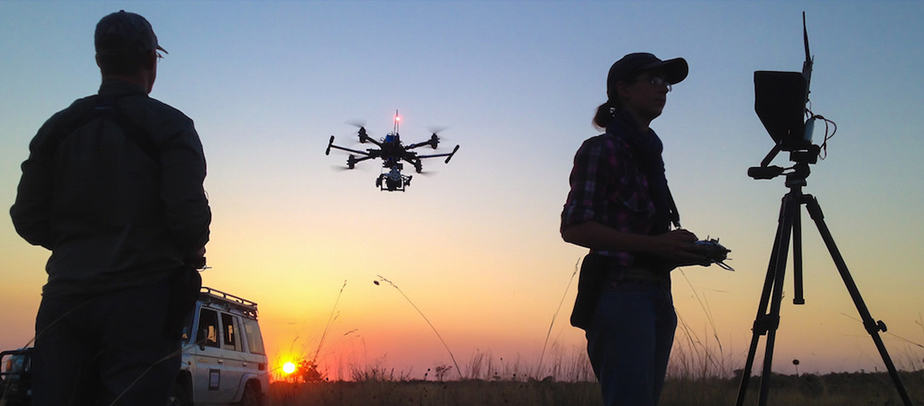
It’s also important to note that the use of commercial drones at night is really only just getting started. There are many businesses looking to utilize night-time drone flying to improve their processes, so it’s only a matter of time before more commercial drones are used at night far more regularly.
From emergency services using drones for search and rescue operations, to global retail powerhouses such as Amazon that want to increase speed and time with their deliveries – commercial drone flying will be a pivotal component of countless organizations as we move forward in this new digital age.
(We’re predicting a major growing trend with the need for commercial drone pilots in the coming years – so this might be one to start looking at if you’re searching for ways to make money from your drone!)
VIDEO: Flying 2,018 Drones At Night
To celebrate Intel’s 50th anniversary, in July of 2018 their drone team set an official world record by flying 2,018 of their Shooting Star™ drones simultaneously to create the biggest and brightest synchronized drone light show ever seen on earth. Click below to watch this incredible 2-minute video.
Why Not Fly a Drone at Night?
Okay, so we’ve looked at some of the reasons why pilots typically want to fly their drone at night… now lets look at some of the reasons to be a little more cautious, or even decide against it.
To start with, flying a drone during the day as a hobbyist can be difficult enough as it is – now imagine doing so with next to no visibility.
… And this is true even when flying in well-lit areas such as a park or out in your backyard, as drones often fly well above the lights and can quickly become difficult to spot in the night sky.
It’s definitely easy to lose sight of your drone or accidentally lose track of it’s flight – and this could lead to a collision which might severely damage the drone, any surrounding property or environment, or worse still, a person that just happens to be in the wrong place at the wrong time.
In addition, you also run the risk of invading someone’s privacy when flying at night. Whether going above a house, backyard, or zipping through the streets, people may get very annoyed about your drone flying around them or their property…
Moreover, when a drone is flying around the night sky and it’s not obvious who is controlling it – people do tend to get a bit nervous and have been known to even mistake it for something else – this has actually led to a huge surge in accidental UFO sightings!
Click the play button below and check out this video from london-based Film Director and Photographer, Oliver Astrologo. He mounted an LED to his DJI Mavic to create this incredible UFO effect – albeit with a little help from some post-editing and background music!
But above all else, and this is probably the most important reason to consider – it might actual be illegal – and depend what you’re doing and where you’re flying your drone, especially if you need but don’t have that all important commercial pilot’s night waiver.
And trust us when we say, the last thing you’re going to want to deal with is having your drone confiscated and having to pay a costly fine!
So whatever you do – use common sense, think ahead and prepare yourself properly, consider your purpose, and go have some fun!
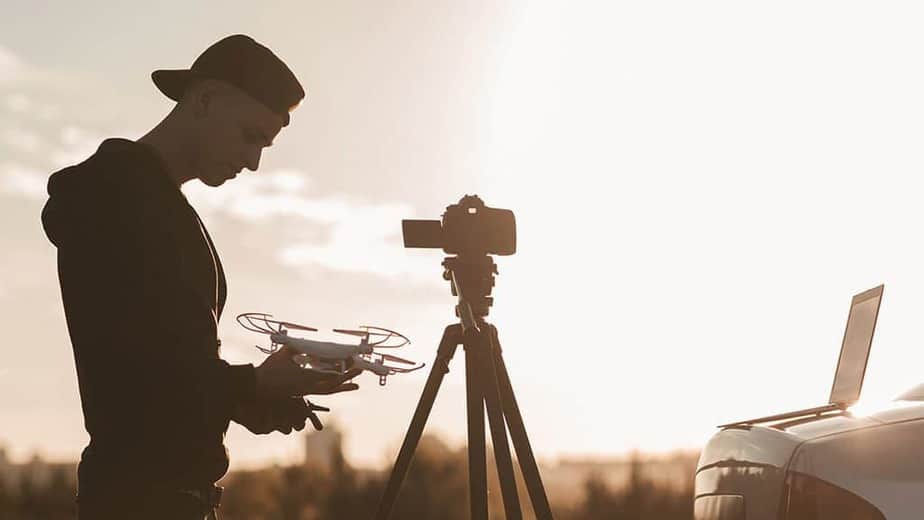
Tips and Tricks for Flying a Drone at Night
Now that all the boring stuff is out of the way it’s time to have some fun! You should now know whether you need a night waiver or if you’re already able to fly your drone once its dark, but that doesn’t mean you’re out of the fire yet!
We’ve mentioned reasons why you may want to avoid night drone flying, mainly how it can be difficult and increase the risk of damaging or losing your drone. However, with a few tips and tricks up your sleeve, you’ll find night drone flying not only great fun but very easy to do!
Before You Fly – Picking the Right Spot and Staying Safe
Before you even think about exploring the night sky with your drone, it’s important to plan ahead, especially when flying in these conditions for the first time. For this reason, we highly recommend starting in an area you know well.
This could be somewhere you are already familiar with or a place you’ve chosen specifically for flying. Take the time to soak up the environment during the day – use your drone to take some photos and videos to help with this!
Look around and see what obstacles may get in the way of your drone – think trees, power lines, buildings, streetlights and everything in-between. When you know exactly where something is at night-time, you’re far less likely to crash into it.
The idea is to become familiar with your surroundings to the point where you’re comfortable flying when its much darker at night. Not only does this reduce the chances of crashing or losing your drone, it keeps you safe!
As any drone enthusiast will say, it’s very easy to get caught up in your flying, so being aware of your surroundings will keep you safer. Cities are often a bit dodgy come nightfall, so it’s always important to be focused on your surroundings, even when in the middle of an awesome flying sequence or photo shoot.
In fact, it may be a good idea to bring a friend along for the ride, as it never hurts to be extra cautious when exploring somewhere at night.
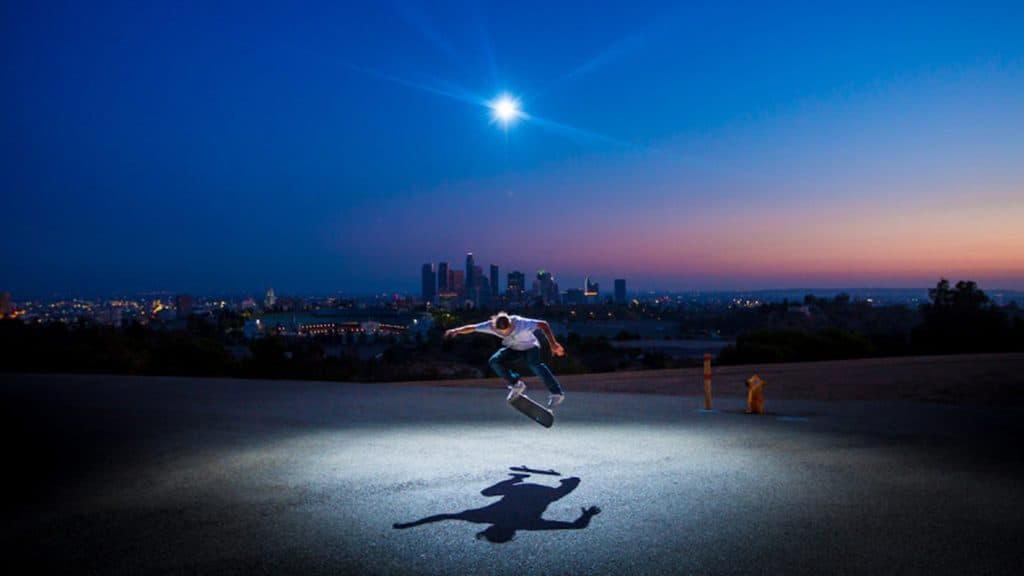
Prepping Your Drone – Settings for Safe Flying
Plan ahead by making sure your batteries are fully charged and that you’ve definitely packed your spares – the last thing you want is for you to arrive at your destination and realise you’ve only 10-15-minutes flight time!
Don’t forget to bring an SD card that has plenty of space for your photos and video, and remember to charge your controller and/or phone… and if your drone doesn’t have an anti-collision light, make sure you attach one before flying.
Here’s a quick video of professional mountain biker, Loïc Bruni, on a downhill trek at night with a drone being used to light up his trail.
Also, you’ll want to adjust a few settings on the drone to make it suitable for night operation. For example, adjust the altitude to ensure you don’t exceed 400ft – the maximum height permitted for night-time flying by the FAA in the US.
In fact, you may find increasing your flight altitude ends up being a good thing, as this reduces the chances of colliding with something. We find anywhere between 200-300ft is a good choice. Yes, 300ft may seem like a lot if you’re not used to it, but you’ll be able to avoid most on-the-ground objects by doing it this way.
After a few tries you’ll find a sweet spot in height that works for you and your environment.
You may also want to set a maximum distance before you head out too, as this will ensure you don’t stray too far away. If your drone has it, set your Return To Home to a distance you know or feel will be safe for night-time excursions!
Also, if taking photos, which I guess is your primary reason for flying at night, consider adjusting the front LEDs to automatically turn off the front lights whenever you take a photo. This will avoid a nasty red blur that almost always ruins your snaps.
Keep Your Eyes on the Prize – Don’t Let the Drone Out of Your Line of Sight
This is an obvious bit of advice but one still worth mentioning again – don’t let the drone fly out of your line of sight!
It’s easy to stop looking at the drone and onto your controller screen, but this a huge risk when flying at night. Typically, your drone camera won’t offer the best visibility on your controller screen, making it easier to crash into unexpected obstacles… so focus on the LEDs illuminating the drone in the sky.
Furthermore, if there is a lag between the drone and the controller screen then you’re even more at risk of colliding with something as the drone’s flight path is a few seconds ahead of what you see.
How to Use a Drone to Take Amazing Night Photography (for beginners)
Aerial night photography is truly beautiful and one of the big reasons to head out after sunset with your drone… because you can navigate the drone to various positions in the night sky, you can take photos that aren’t possible with a normal on-the-ground camera.
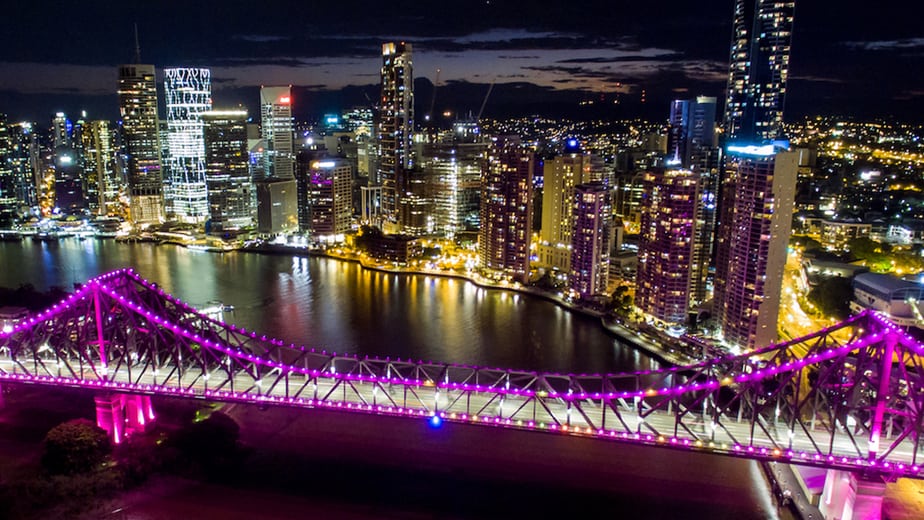
One style of night photography that is quite easy to capture with a drone is long exposure photos. This is basically when you slow the drone camera shutter speed to capture images with moving and stationary objects to create a unique effect.
The moving lights create a blurry and streaky effect while the still objects remain in place like a normal photo – think the moving stars across the night sky or the moving car lights across a bridge.
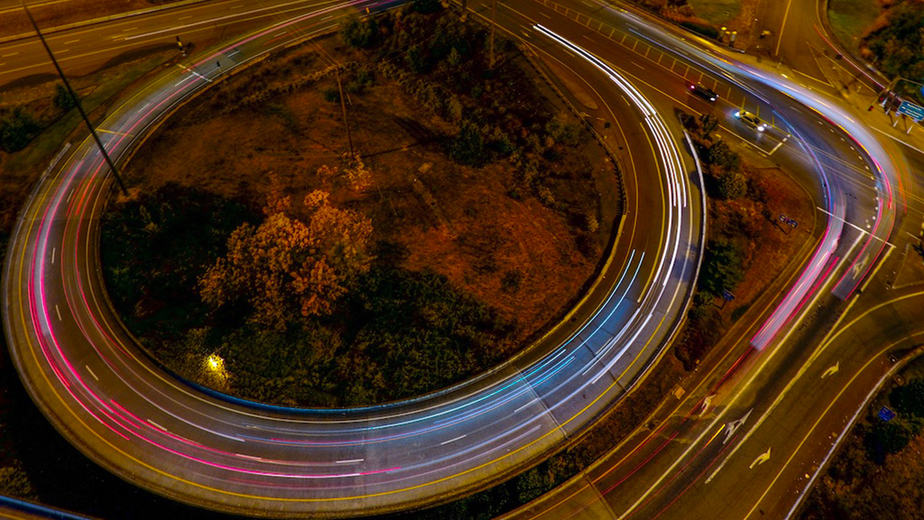
Not only can the photos look fantastic, they are also surprisingly easy to capture with a drone! All you need to do is make a few adjustments to the camera settings and know how to position the drone correctly, but other than that you can easily take long exposure photos on your first night out flying.
Adjusting Drone Camera Settings
There are three main settings you need to adjust to take a long exposure photo from your drone camera.
Firstly, you need to reduce the ISO to the lowest setting possible, preferably 100 and no more than 200. The ISO is a camera’s sensitivity to light, so the lower it goes the more detail you tend to capture, with darker images (e.g. those taken at night) looking much better.
Second it the aperture. This is the hole inside of a camera lens that dictates how much light passes through. Low settings increase the brightness of the image while high settings offer darker images. You can play around with this, starting low and seeing how the image looks, increasing it if you want more brightness.
Finally, you need to alter the shutter speed settings. Shutter speed is the time it takes the shutter to open and close to let in light needed to take a photo, so you’ll want to change the speed for long exposure photos. Different shutter speed settings can be used for long exposure photography – anywhere between 1.5 to 8 seconds can work. Lower speed settings between 1.4-4 seconds.
Again, play around with all three settings for each photo to see what works best for you and your environment!
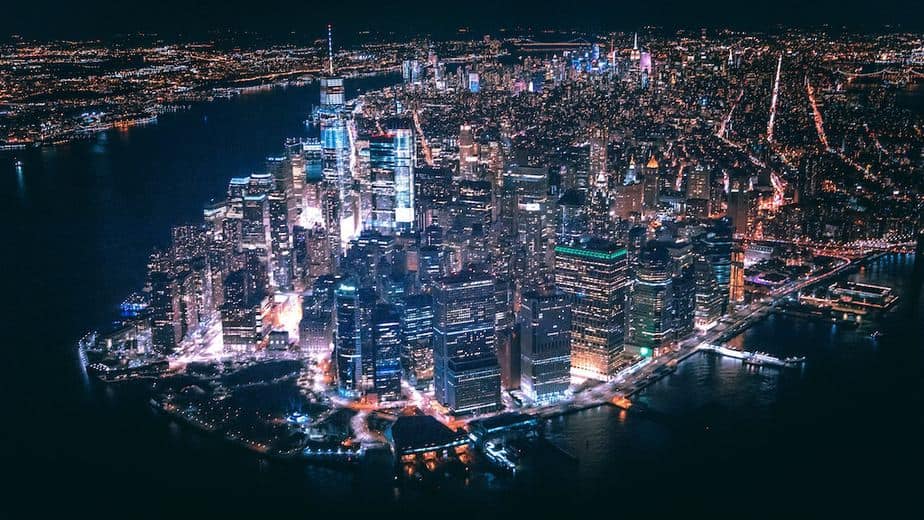
Tips for Taking Long Exposure Photos from Your Drone
Choose the Right Location – The best long exposure photos involve moving lights against still objects, so busy urban landscapes are perfect for this. Anywhere with lots of lights, buildings, and vehicles are ideal.
Plan the Location Advance – As we mentioned in tips and tricks, picking the right spot and staying safe is very important, so make sure you do this! Moreover, you want to find the best area to take off and land from.
Pick a Calm Night – As any drone pilot knows, windy conditions are a nightmare to fly in, and these conditions can also ruin your long exposure photos. The camera may not stabilize images well with longer shutter speeds when it’s too windy.
Make Edits – Even the best long exposure photos look nicer with some editing, so consider playing around with them to get the perfect finish. Adjust things like white balance and the detail in darker areas, while doing your best to remove noise from the image. There are great tutorial videos online that can help with this process!
Seasonal Flying – Things to Consider When Night Flying Throughout the Year
While it’s safe to assume that most night drone flying will occur in the summer months, many enjoy taking their drone out at night throughout the different seasons, often when the weather is less than perfect.
Afterall, when the days get shorter there is less time to fly during daylight, so there is an increased chance of night flying – assuming you can brace the elements!
Spring Nights
Spring is one of the best times to fly a drone at night. The nights are cooler and the weather is getting better, giving the perfect chance to take to the night’s sky after a long winter. However, there is one big risk of flying at night during spring – lots of rain.
While a great thing for the plants, flowers, and crops, spring rains aren’t the best for drone pilots looking to fly at night. Flying in rain is quite dangerous, as not all drones are built to handle moisture exposure when flying in the rain.
Doing so may cause damage to the motors and electronics, so it’s always advised that you avoid flying during a rainy night – which won’t be too challenging unless you enjoy getting a bit wet!
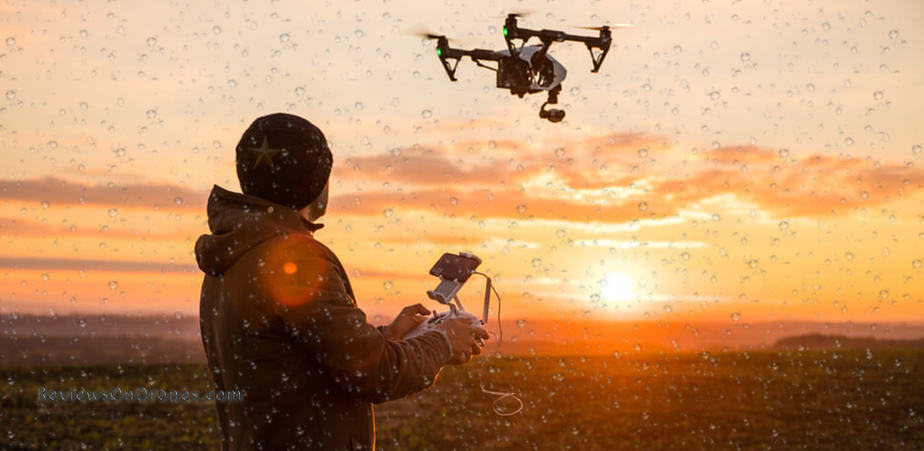
Summer Nights
Easily the most popular season for drone flying, it’s common to see pilots taking their drones out during the day or night, with cooler temperatures and calm nights providing the perfect flying conditions.
This is true in most instances, although there are a few things to remember when flying a drone during a hot summer’s night.
For example, higher temperatures bring thinner air, which has an unexpected impact on the drone, forcing the motors to work much harder than normal. Furthermore, the heat will cause motors to heat up at a faster rate, making them less efficient.
Heat also lowers battery performance, so this can all combine to result in less battery time and even overheating. Thankfully, most night-time temperatures are cool enough where this won’t be much of an issue, unless you live in dry and arid states.
So, summer actually represents the best season for flying a drone at night, as it may be too hot during the day! If you’re curious about night-time flying, summer is the perfect time to try it out, providing it isn’t too hot!
Autumn Nights
Autumn won’t see much of a change in terms of weather conditions. It often gets windier and colder, although rarely to point of severely hampering your drone flying. Common sense prevails in this instance. Simply avoid overly windy and wet nights.
Remember, excessive winds make drone flying challenging and this is even more prevalent at night. It will also reduce the battery life by forcing the drone to work harder and increase the changes of crashing into something.
Wait for calm nights during autumn to ensure its safe to fly the drone and reduce the chances of damaging or losing it.
Winter Nights
Winter is a bit trickier when it comes to flying your drone at night. For example, colder temperatures will impact the battery performance, with lithium-ion batteries losing efficiency in these conditions due to a reduction in chemical activity inside the battery.
So, when its cold outside at night your drone will have less battery life. This means your drone may fail quicker than you expect, often resulting in an accidental crash or losing sight of the drone where it lands.
There is a way around this issue though – warm your battery up before properly taking off.
You can buy battery heaters from companies like DJI that will warm the battery prior to use, reducing the impact of cold weather.
These aren’t available for all batteries though; in this case you can try hovering the drone shortly after taking off to heat it up without quickly draining the battery.
Much like rain, snow can cause significant damage to the drone. This includes moisture damage to the motors and electronics, while any snow that gathers on the drone will increase the weight and therefore drain the battery quicker.
Of course, a snowy winter night does offer the chance to take some wonderful photos and videos, so you’ll either want to invest in a water-resistant drone or wait until it has stopped snowing.
Also, be mindful of taking off and landing in the snow at night! Consider bringing something you can lay onto the ground surface area to keep the drone dry. This is especially important in the snow and rocky terrains.
Two of the most popular drone launch and landing pads available on the market are the Pgytech and the Hoodman. Both come in various diameter sizes to suit your drone type, and the price is dependant on your choice.
We use the Pgytech Pad simply because its the least expensive option, but reviews on Amazon for both are excellent, and most will base their decision on budget.
Click each of these links to read more about the Pgytech Launch and Landing Pad and the Hoodman Pad on Amazon.
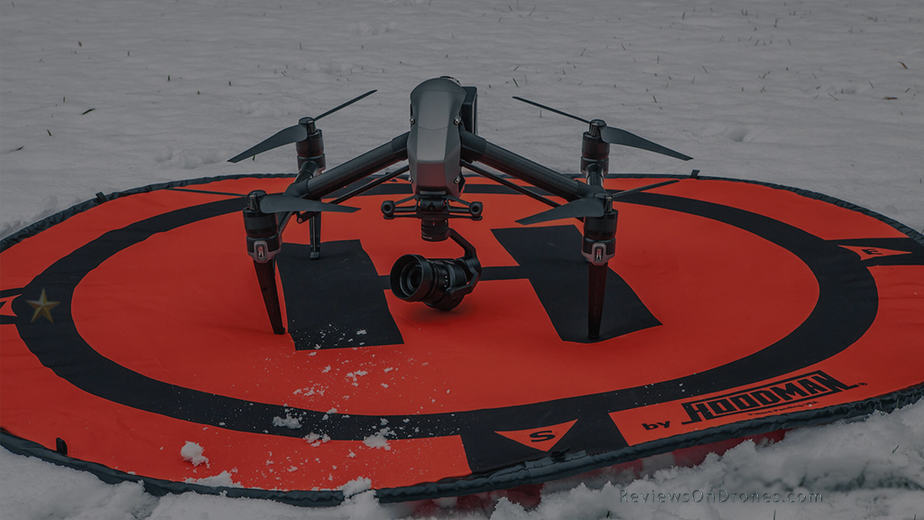
Finally, bear in mind that winter often brings the worst visibility conditions for drone flying. Combining the low visibility of night and winter weather means you may want to limit your night-time flying, unless the weather isn’t too severe.
LEDs may help with visibility, but check the weather forecast in any case to double check that the drone visibility is within FAA rules – minimum visibility is three miles.
Let’s not just focus on the drone though! You need to ensure that you are wrapped up warm for night-time flying during the winter months, so be sure to wear appropriate clothing and footwear. A good pair of gloves is recommended to ensure they aren’t too cold and stiff to use the controls!
Crashing Your Drone at Night – What to Do if it Happens and How to Avoid it
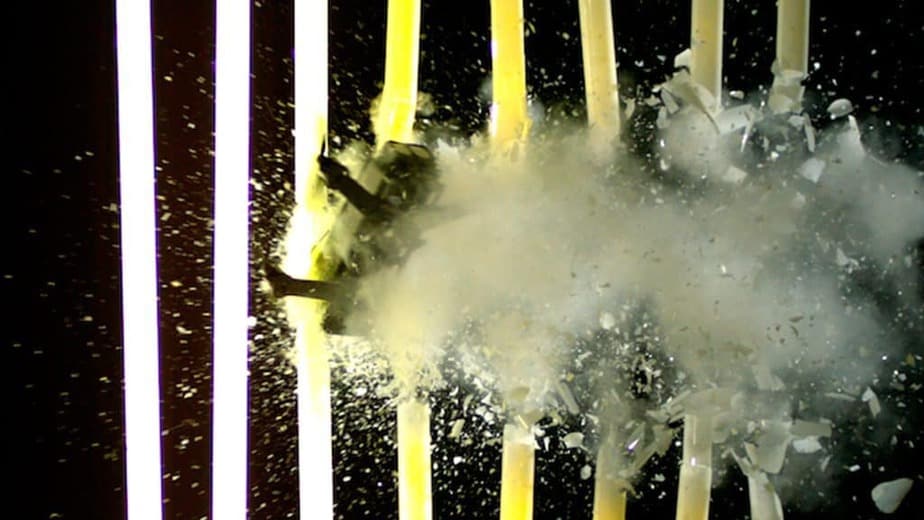
If there is one big drawback about flying a drone during the night, it’s the increase chance of crashing it. While many view your first drone crash as a right of passage, we all want to avoid doing it at night – nobody wants to search around for a lost drone in the dark!
Sadly, night-time provides the perfect conditions for drone crash. Low visibility means increased chances of colliding with unseen objects while it’s easier to lose sight when flying in the dark.
When flying at night, there is a chance you will crash the drone and lose sight of it in the process, especially when flying for the first few times. You may not even be a fault for a night-time drone crash – an unexpected failure can happen at any time of the day!
Reasons a Drone Might Crash at Night
Here are just a few reasons why your drone might crash at night:
- Low visibility causes it to crash into a building, tree, or other unseen object
- Accumulated rotor damage causes rotor failure mid-flight
- Lose GPS signal
- Compass error due to radio or magnetic interference (e.g. flying too close to a cell phone tower)
- Issues with return home function (e.g. pushing it too soon or signal interference)
- Low battery
Thankfully, most of these issues are easy to avoid with proper preparation.
How to Avoid Crashing Your Drone at Night
The first piece of advice is simple – always keep the drone within your line of sight. The FAA make this an important rule for a reason, as it ensures you can always retrieve the drone in event of a crash.
This is very important for flying at night, as the low visibility makes it more difficult to find your drone if you haven’t kept your eye on it.
Take advantage of your drone’s LED lights or equip an external one to help keep it visible.
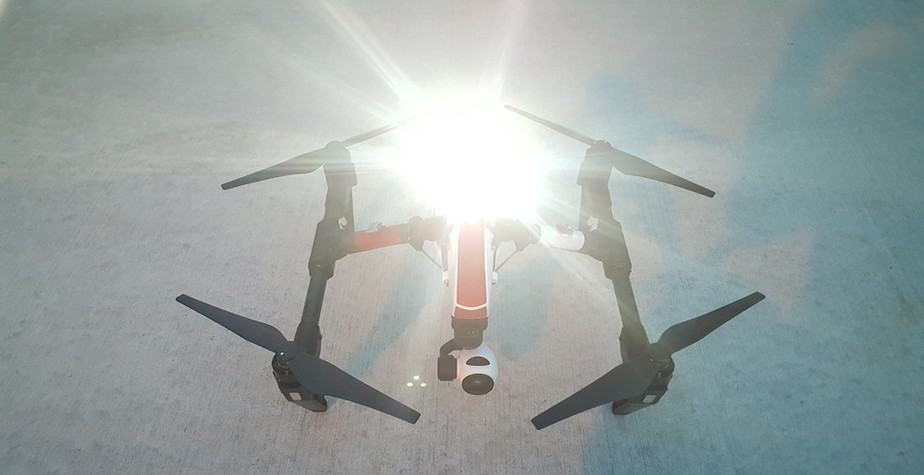
Buying a Drone Tracker
Another worthwhile consideration is to purchase an external drone tracker. Check to see whether your drone might have tracking systems already built-in, as these are common in many of the top drones such as the DJI Mavic Air, Mavic Pro, and Phantom 4 Pro.
If not, there are many drone trackers available online and these are an invaluable investment for your drone regardless of when you’re flying.
These devices most often use GPS (some use radio waves) to provide the coordinates (and therefore location) of your drone, making them especially handy for night flying. Simply attach it to the hull of the drone and activate when flying and you’ll receive a signal of the drone location if you lose sight of it.
Depending on the type of tracker, you’ll receive coordinates via an App, through SMS or directly on Google maps, which you then use to find the drone.
Some are more advanced than others, having additional features such as using both GPS and cellular signals for increased accuracy, while others have a better battery life and range. Here are some considerations to make when buying a drone tracker:
Weight – The heavier the tracker the more battery it drains! Make sure it’s not too heavy, especially when a using smaller drone.
Signal strength – Some can track the signal for several miles while others are designed for shorter distances, so check this and ensure it meets your needs.
Battery life – Most trackers are externally charged so check what battery life they offer and the time to recharge. Some can use the drone battery for power but this will reduce flight duration.
Ongoing costs – Some drone trackers do have an ongoing subscription cost, which can make them prohibitive for the newbie pilot, so be mindful and check to see if there is anything you might need to pay in addition to the tracker kit.
Of all the drone trackers on the market, there are three that seem to be the more popular than others – although to be honest we haven’t used any of these so we can’t really make comment from our own experience.
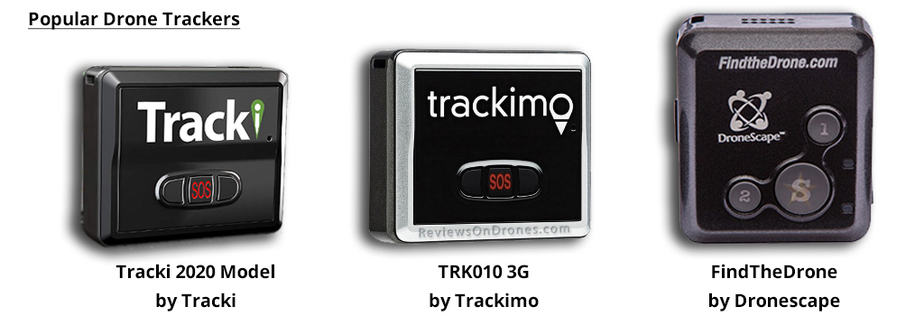
If you are looking for a tracker, we suggest you start with these and see where your research takes you – Tracki – Trackimo – FindTheDrone.
How to Find Your Lost Drone at Night
Of course, sometimes things will go wrong even on the best planned nights, so it helps to know what to do if you crash your drone at night. If you don’t have any tracking device on the drone then finding it is more challenging, especially when it’s dark outside!
If you’ve lost the drone due to some sort of connection issue, then the drone is still possible to retrieve using the return home feature. Keep the controller on and keep hitting the return home button as you search for the drone, as it may connect when you come within range and fly back to you.
Another method is quite simple – start searching on foot and use your eyes and ears to try and locate the drone. Look around trees, bushes, and any areas where the drone might be stuck, using the last place you saw the drone as your starting point.
You might need to cover a large area so patience is key here. When its darker you may find the LED light flashing as you get closer to the drone, so keep looking for signs of flashing lights as you search.
Similarly, listen carefully for any noise the drone makes, including the motors, rotors, and any other noise it may produce. Spinning rotors often hit off objects when a drone is stuck somewhere, so listen out for this.
If you’re still struggling to find the drone then try looking at the devices you’re using, as many of these come with handy features that can help give you a better idea of where to start looking.
For example, when a drone has a smartphone application is usually includes a form of data log, such as coordinates, while many controllers record flight paths that you can check to see its last location.
Should you still struggle to find the drone then you may need to give up for the night and come back early the next morning when there is better visibility. Failing that, consider drawing up some lost drone posters and placing them around the area – you could even check eBay for recent listings of the drone model in your area in case someone has found it.
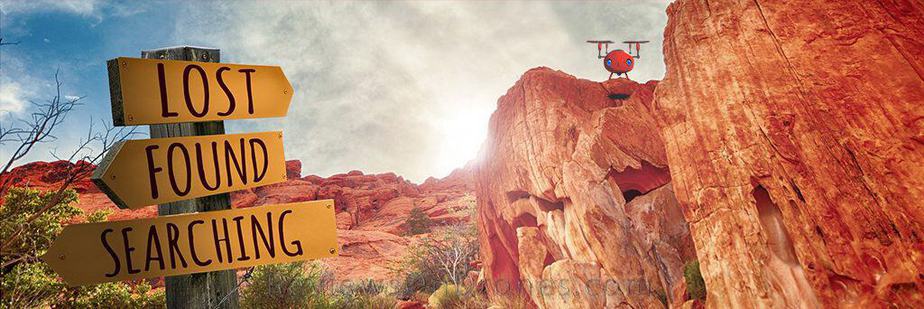
Not in the US? A Quick Overview of the Different Laws Around the World
If you’re in the USA and wondering what laws apply to your country then fear not – we’ve got a quick guide to different laws around the world. Thankfully, many of the laws are very similar to those in the US, with lawmakers appearing to find common ground on most of the rules about flying drones at night.

Canada 🇨🇦
It’s 100% legal to fly a drone at night in Canada, providing you follow their rules and regulations.
Canada’s drone laws are managed by Transport Canada Civil Aviation (TCCA). Drone flying is divided into two categories in Canada – basic and advanced drone operation. Each type of operation requires specific pilot certificate and registration of the drone, while you’ll also need to follow general rules of drone operation.
The only time you don’t need to register the drone and get an appropriate licence is if it weighs less than 250g. In this situation, you’re free to fly your drone at night in Canada providing you follow standard safety rules.
If not, you need to get the appropriate certificate and register the drone. After this, you must ensure the drone has proper lighting to be visible within your line of sight, while also avoiding breaking rules regarding where to fly the drone.
Certain areas in Canada do not permit any type of drone flying, including at night-time. It’s mostly common sense, avoiding flying over public events, airports, hospitals, police stations etc. One notable area where it is illegal to fly in Canada is in the National Parks.
For a more detailed break-down of drone laws in Canada, check out the official guidelines from Transport Canada.

United Kingdom 🇬🇧
It is completely legal to fly a drone at night in the UK providing you follow all safety rules and laws.
Drone laws in the UK are set to be more tightly regulated at the end of 2019, with the UK Civil Aviation Authority (CAA) currently working on updating current laws that will restrict the use of drones throughout the country.
This is because of some recent issues with consumer drones causing massive security issues and subsequent delays at major UK airports over the past year.
The biggest chance is the introduction of many new no-fly zones, which are mainly around airports and prisons. So, you can’t fly a drone at night anywhere near a UK airport or prison!
Like Canada, all drones that weigh more than 250g will also need to be registered, with the new law coming into effect November 2019
Beyond this, regulations are quite similar to those in the US. For instance, if you are using the drone at night for commercial reasons then you will need permission from the CAA, much like applying for a night waiver.
If not, you won’t permission to fly at night, although you do need to follow these standard drone flying rules:
- The drone must always stay in line of sight
- Fly no higher than 400ft
- Remain 50m from property
- Remain 150m from large crowds
FAQ About Flying a Drone at Night
What is considered night flying?
Night flying is classified as civil twilight, meaning 30 minutes after sunset, so if you fly your drone at this time it’s considered night flying and you may need a waiver.
How long does a night waiver last?
A night waiver lasts for four years.
Is there are a fee for applying for a night waiver?
No! It’s free to apply for a night waiver.
Where can I fly with a night waiver?
Under current rules a night waiver grants access to all Class G airspace, which is basically all uncontrolled airspace below 14,500ft. You won’t be able to fly near airports unless you have authorization from the airport.
How long does it take to get approved for a night waiver?
It will take up to 90 days to process your application and get approved or denied for a night waiver. You may not find it takes the entire 90 days, especially if you provide detailed information during the application.
Do I need to apply for a night waiver if I’m flying recreationally?
Nope! If you’re flying as a hobbyist then you don’t need any night waiver and simply need to follow the standard FAA safety rules for all drone pilots in the US.
Do I need an anti-collision light if I’m flying for fun?
Technically no, but we highly recommend buying one. It’s not illegal to fly without one but very difficult, increasing the risk of crashing or losing the drone.
What’s the best color for an anti-collision light?
A combination of red and white strobe lights works the best. These combine well to increase visibility from several miles away.
What can drones see at night?
It depends entirely on the quality of the camera. The best camera drones are capable of amazing night photography with the right settings. Some also have night vision that can be viewed from the FPV.
Final Thoughts
There you have it – the ultimate guide to flying a drone at night, legally!
It may seem daunting at first, yet once you understand what rules apply to your individual situation, it’s very straight-forward.
Common sense should prevail in most situations – the only big change is if you plan on making cash out of your late-night flying – and even then, it’s not too complex to get the all-clear. We cannot recommend enough how much fun is to be had, and how fulfilling it is fly a drone safely at night.
Most challenges can be overcome, incredible footage captured, and the opportunity to fly your drone from a completely new perspective. But don’t take our word for it – get those rotors attached, batteries charged, and go find out for yourself – you’ll be happy you did!
